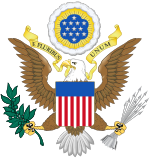
Back سياسة الولايات المتحدة Arabic ABŞ siyasi sistemi Azerbaijani Държавно устройство на Съединените американски щати Bulgarian Politika Sjedinjenih Američkih Država BS Política dels Estats Units Catalan سیاسەتی ویلایەتە یەکگرتووەکانی ئەمریکا CKB Politický systém Spojených států amerických Czech Politisches System der Vereinigten Staaten German Πολιτικό σύστημα των ΗΠΑ Greek Política de los Estados Unidos Spanish
Politics of the United States | |
|---|---|
 | |
| Polity type | Constitutional federal republic |
| Formation | March 4, 1789 |
| Legislative branch | |
| Name | Congress |
| Type | Bicameral |
| Meeting place | Capitol |
| Upper house | |
| Name | Senate |
| Presiding officer | Kamala Harris, Vice President & President of the Senate |
| Appointer | Direct Election |
| Lower house | |
| Name | House of Representatives |
| Presiding officer | Mike Johnson, Speaker of the House of Representatives |
| Appointer | First-past-the-post voting |
| Executive branch | |
| Head of state and government | |
| Title | President |
| Currently | Joe Biden |
| Appointer | Electoral College |
| Cabinet | |
| Name | Cabinet of the United States |
| Current cabinet | Cabinet of Joe Biden |
| Leader | President |
| Deputy leader | Vice President |
| Appointer | President |
| Headquarters | White House |
| Ministries | 15 |
| Judicial branch | |
| Name | Federal judiciary of the United States |
| Courts | Courts of the United States |
| Supreme Court | |
| Chief judge | John Roberts |
| Seat | Supreme Court Building |
| This article is part of a series on the |
| Politics of the United States |
|---|
 |
In the United States, politics functions within a framework of a constitutional federal republic. The three distinct branches share powers: the U.S. Congress which forms the legislative branch, a bicameral legislative body comprising the House of Representatives and the Senate; the executive branch, which is headed by the president of the United States, who serves as the country's head of state and government; and the judicial branch, composed of the Supreme Court and lower federal courts, and which exercises judicial power.
Each of the 50 individual state governments has the power to make laws within its jurisdiction that are not granted to the federal government nor denied to the states in the U.S. Constitution. Each state also has a constitution following the pattern of the federal constitution but differing in details. Each has three branches: an executive branch headed by a governor, a legislative body, and a judicial branch. At the local level, governments are found in counties or county-equivalents, and beneath them individual municipalities, townships, school districts, and special districts.
Officials are popularly elected at the federal, state and local levels, with the major exception being the President, who is instead elected indirectly by the people through the Electoral College. American politics is dominated by two parties, which since the American Civil War have been the Democratic Party and the Republican Party, although other parties have run candidates. Since the mid-20th century, the Democratic Party has generally supported left-leaning policies, while the Republican Party has generally supported right-leaning ones. Both parties have no formal central organization at the national level that controls membership, elected officials or political policies; thus, each party has traditionally had factions and individuals that deviated from party positions. Almost all public officials in America are elected from single-member districts and win office by winning a plurality of votes cast (i.e. more than any other candidate, but not necessarily a majority). Suffrage is nearly universal for citizens 18 years of age and older, with the notable exception of registered felons in some states.